The Mining of Fullers Earth at Woburn Sands
The mining of Fullers Earth has been an integral part of Woburn Sands trade, commerce and employment for over 700 years. It is mentioned in the Inquisition of Aspley in 1295 A.D.
Most of the area between Woburn and Woburn Sands, and places on Aspley Heath and parts of Aspley Guise have been mined, firstly by small scale operations by hand, then later with Victorian industrial assistance and finally by large scale open mine techniques. Much has already been written about the process, and I have gathered some of the best sources here.
An early eye-witness account of the pits comes from a letter from the Reverend Mr. B. Holloway, to a Dr. Woodward, in 1723, as published in “Philosophical Transactions” vol. 32.
An Account of the Pits for Fullers-Earth in Bedfordshire “I went a few days ago to the Fullers’ Earth Pits at Wavendon near Woburn, where there are several pits now open, but, as men were then at work only in one, and I understood the Earth was disposed in much the same manner in all, I did not trouble my self to go down into more than that wherein they were then digging; in which I found things disposed thus.
From the surface, for about six yards depth, there are several layers of sands, all reddish, but some lighter coloured than others, under which there is a thin stratum of red sand-stone, which they break through; and then for the depth of about seven or eight yards more, you have sand again, and after that come to the fullers-earth; the upper layer of which, being about a foot deep, they call the Cledge and this is by the diggers thrown by as useless, by reason of its too great mixture with the neighbouring sand, which covers, and has insinuated itself among it: After which they dig up earth for use, to the depth of about eight feet more, the matter whereof is distinguished into several layers there being commonly about a foot and an half between one horizontal fissure and another. Of these layers of Fullers-Earth, the upper half, where the earth breaks itself, is tinged red, as it seems by the running of water from the sandy strata above; and this part they call the Crop, betwixt which and the Cledge above-mentioned, is a thin layer of matter not an inch in depth, in taste, colour, and consistency, not unlike to Terra Japonica. The lower half of the layers of Fullers’ Earth, they call the Wall-Earth; this is untinged with that red above-mentioned, and seems to be the more pure and fitter for Fulling; and underneath all is a stratum of white rough stone, of about two foot thick, which, if they dig through, as they very seldom do, they find sand again, and then is an end of their works.
One thing is observable in the site of this Earth, which is, that it seems to have everywhere a pretty equal horizontal level; because they say, that when the sand-ridges at the surface are higher, the Fullers-Earth lies proportionably deeper.
In these works they seldom undermine the ground, but as they dig away the earth below, others are employed to dig and carry off the surface, otherwise, the matter above, being of so light and flitting a nature, would fall in and endanger the workmen: for, as was observed before, that stratum of sand-stone, which occurs before they come to the Fullers-Earth, does not lie, as in coal-pits, immediately over the matter they dig for, like a ceiling, but even in the midst of the superjacent strata of sand, and therefore can be no security to them if they undermine. The perpendicular fissures are frequent, and the earth in the strata, besides its apparent distinction into layers, like all other kinds of matter, by reason of its peculiar unctuousness, or the running of the adjacent sand imperceptibly among it, breaks itself into pieces of all angles and sizes.
For the geographical situation of these pits, they are digged in that ridge of sand-hills by Woburn; which near Oxford is called Shotover; on which lies Newmarket-Heath by Cambridge, and which extends itself from east to west, everywhere, at about the distance of eight or ten miles from the Chiltern Hills, which in Cambridgeshire are called Gog-Magog; in Bucks, and Oxon, the Chiltern Hills, from the chalky matter of which they chiefly consist:- which two ridges you always pass, in going from London into the north, north-east, or north-west counties in the manner I before-mentioned: after which you come into that vast vale, which makes the greater part of the midland counties of Cambridge, Bedford, Bucks, Northampton, Oxford, and Gloucester, and in which are the Rivers Cam, Ouse, Nen, Avon, Isis, and others; which I take notice of, because it confirms what you say of the regular disposition of the earth into like strata, or layers of matter, commonly through vast tracts, and from whence I make a question, whether Fullers-Earth may not probably be found in other parts of the same ridge of sand-hills, among other like matter.”
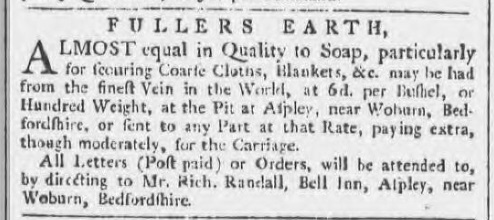
“FULLERS EARTH – ALMOST equal in Quality to Soap, particularly for scouring Coarse Cloths, Blankets, &c. may be had from the finest Vein in the World, at 6d. per Bushel, or Hundred Weight, at the Pit at Aspley, near Woburn, Bedfordshire, or sent to any Part at that Rate, paying extra, though moderately, for the carriage.
All Letters (Post paid) or Orders, will be attended to, by directing to Mr Rich. Randall, Bell Inn, Aspley, near Woburn, Bedfordshire.
At Bedford and Luton Archives and Records Service is a letter in the Russell collection (R3/1688) from July 1795, discussing the Dukes attempts to distribute Fullers Earth.
“The fuller’s earth dug at Hogsty End, near Woburn, is of very superior quality, a considerable quantity is sold to persons who fetch it from the pit; it goes to Witney in Oxon. & many other parts equally distant, but the land-carriage is so expensive it won’t answer at the London market. By His Grace’s directions I sent 3 ton to town last year as an experiment, & to make its superior quality known; the carriage cost 45s. per ton & when arrived in London it sold at 20s. per ton; probably Messrs. Smith, Mills, Birkett & Co. have some of it yet by them. Altho’ it won’t pay at present, I am in hopes of vending a considerable quantity in town when the Grand Junction canal is completed, as the mine lies within 2 1/2 miles of the line… The bed is full 6′ thick without any mixture whatever, and greater part free from dirty red crust usual.”
The following excellent illustrated description of 19th century mining comes from the “Leighton Buzzard Observer and Linslade Gazette” of 29th October 1895:
“The Woburn Sands Fuller’s Earth Mining Industry”
“From time immemorial, what is known commercially and scientifically as fuller’s-earth, by reason of its adaptability to the process of fulling cloth, has been mined in the neighbourhood. Up to within the last two or three decades, the procuring of the earth has been looked at moiré in the light of as paying hobby than a strict commercial speculation. The methods adapted for its procuration were very crude, those engaged in the mining contenting themselves with merely sinking a shaft to the layer of earth, and then digging around until the falling in of sand became dangerous, when work was abandoned, and a shaft sunk in a different place, and so on. Although this method of obtaining the earth was very expensive, it must be borne in mind that competition in this particular commodity was then practically unknown, so that those who were fortunate enough to possess land under which the precious earth was found could command what price they liked for it. But the discovery of other beds in different parts of the country rendered it necessary that the earth should be obtained by a less expensive process, and the help of mining engineers was therefore requisitioned, with the result that thousands of tons are now obtained annually from the different mines in the country.
Through the kindness of Mr. J. Milne and Mr. A. J. G. Swinney, we are this week enabled to place before our readers an illustrated description of two of these concerns, which, for size, and the quality of the earth obtained, compare favourably with any in the country. Before entering into a description of these mines, it may not be out of place to give some information as to the character (both geological and otherwise) of this useful substance, as well as a description of the process of “fulling.”
Fuller’s-earth, which is generally of a greenish-white colour, more of less mixed with brown, grey or yellow, was first geologically named by William Smith in 1816. It is of a soft, friable texture, somewhat unctuous to the touch, and is a hydrated silicate of aluminium, with oxide of iron, magnesia, and other bases, the specific gravity being from 1.7 to 2.4. Before the blow-pipe it fuses ultimately to white glass. When thrown into water, it immediately absorbs it, and breaks down into a fine pulp, without becoming pasty. The most important property of this earth, and that which has given it its commercial value, is its power of absorbing oil or grease, being capable of holding 66 per cent of its own weight of oil, hence its use in removing from woollen fabrics the oil with which the wool has been dressed for wearing, while it is also extensively used in America for the clarifying or purifying lard, oil, &c. Probably fuller’s-earth might also be used for domestic purposes, such as scouring wood, and thus form a substitute for soap, but its insolubility in water, and the consequent difficulty in preventing the earthy particles adhering to the washed surface and giving it a dingy look, is a great drawback to its use for that purpose. Fuller’s-earth which belongs to the colitic and liassic epochs of the secondary or mezozoic period, lies above the inferior colite limestone.
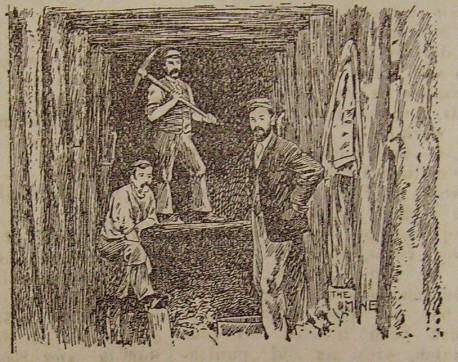
The formation consists of stiff blue clay, which varies in thickness from a few feet to 400 feet near Bath. In the middle, in Somersetshire, there is a thick band of lime stone, called fuller’s-earth rock, and the whole formation is occasionally interstratified with thin bands of shelly limestone, rich in fossils. The deposits of the earth are of a local character, which seems to point to the fact that they were deposited by lakes, the component parts of the earth being brought down by numerous streams which run into these inland seas. The lenticular form of the deposits, gradually getting thinner towards the outside, also give added weight to this theory. Fuller’s-earth has been discovered, in various places, lying between different geological formations.
Thus it has been raised from marl beds at Raddle Pits, near Braithwell, north east of Rotherham, also at Renton, in Yorkshire; from the chalk deposits at Bepton, in Surrey, and the Katesgrove Kiln, Reading; from the Portland stone, at Brill; the Hythe beds of limestone, sandstones etc at Tillington; and in the lower Ludlow rocks of the Paleozoic period an important fuller’s-earth has been discovered. It is the decomposition of this unctuous fuller’s-earth (provincially Walker earth or die earth), beneath heavy masses of the limestone which rest upon it, that has occasioned numerous landslips, both in Ludlow and in neighbouring parts of Hertfordshire. The maximum thickness of the fuller’s-earth formation is estimated to be as much as 400ft., by which thickness, as stated above, occurs near Bath.
In a description of a pit situate at Nutfield, near Reigate, in Surrey, it is said that fuller’s-earth, varying in thickness from 8ft. to 12ft. has been discovered at a depth of 46½ ft. below the surface. The upper part had been discoloured to a buff tint by infiltration of water and the consequent peroxidation of iron.
Coming nearer home, we find that the “Woburn Sands” (termed by the Rev. John Mitchell in 1788, “The sand of Bedfordshire”) are about 220ft. in thickness, fuller’s-earth having been dug from there from time immemorial. The fuller’s-earth occurs rather below the middle part of the sand, viz :- sand, 130ft.; fuller’s-earth, 12ft. (the whole of this not being of commercial value owing to the presence of foreign substance in the form of sand) and sand about 80ft. The water thrown out by this bed is very pure and sweet, and blocks of the earth have been placed in the wells in the neighbourhood to purify the water. Analyses of the earth have been made by Mr. R. H. Harland, F.I.C., F.C.S., with the following results:- Yellow earth (lump): silica, 47.10; alumina, 16.27; oxide of iron, 10.00; lime 2.63; magnesia, 3.15; moisture, 15.12; combined water and organic matter, 5.73; alkalies, none. Yellow earth (powdered): silica 47.20; alumina, 15.66; oxide of iron, 10.64; lime, 2.24; magnesia, 2.00; moisture, 15.44; combined water and organic matter, 5.36; alkalies, .46. Undried blue earth: silica, 40.50; alumina, 12.20; oxide of iron, 6.80; lime, 1.57; magnesia, 1.00; moisture, 33.50; combined water and organic matter, 3.25; alkalies, 1.15. From the foregoing it will be seen that there are two kinds of earth, the blue and yellow, differing very little in their chemical composition, though, for some reason or other, the yellow is more valued commercially.
Fuller’s-earth is not very rich in fossils, the reason for this being that the water impregnated with the different chemical constituents of the earth was not favourable to the sustentation of animal life. The characteristic fossil, according to Lyell, is an oyster. Although some thousands of tons of the earth have been dug from local mines, no fossils have as yet been discovered. Cloth fulling, for which purpose the fuller’s-earth is especially adapted, is a very old industry, for we find that Shakespear in his “Henry VIII” says: “The clothiers had put off, the spinsters, carders, fullers, weavers.”
The object of the process is to condense, strengthen, and thicken the material, with a loss of width and length. The modern fulling mill consists of an iron framework supporting the shanks of heavy wooden mallets, which are raised by projecting cams on a tappet-wheel. The mallets, being raised to their full height, are released, and drop by gravity on the cloth, which is contained in an iron trough beneath. The fibres of the material slip past each other, and their toothed edges interlock, so that a continuation of the process causes them to be more and more intimately associated.
The cloth is folded or rolled and treated with soapy water, fuller’s-earth also being added. It is then beaten with wooden mallets, by which the serrated edges are forced past each other, and the fibres are closely commingled. Cotton cloth is sometimes put between folds of woolen cloth to prevent adherence by felting together.
Fulling has, within the last half-century, like most manufacturing processes, become the subject of adaptations of machinery for the purpose of economising labour, and of improving the finish of the goods. The objects of the process are still however the same.
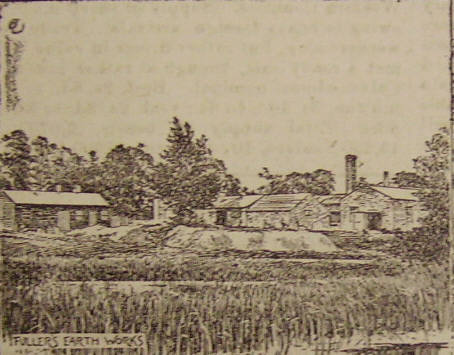
Reverting now to the mining and preparation of the earth, we must ask our readers to accompany us to the works of the Woburn Fuller’s-Earth Company, which occupy a commanding position near the summit of Aspley Heath, 500 feet above the level of the sea. They are bounded on three sides by the lovely woodlands of the Duke of Bedford and Sir Henry Hoare, while at the foot of the hill lies nestling the pretty village of Woburn Sands.
While waiting for the genial proprietor to take us round on a tour of inspection, let us try and picture to ourselves an ideal landscape of the lower oolite period. In a wide expanse of water, bounded by trees of immense growth, we see disporting themselves some of those monsters that are familiar to us only by name. An icthyosaurus is there, with its immense jaws and massive body, while engaged in combat with it is a plesiosaurus, whose long neck and wild looking eyes are enough to strike terror into the heart of the stoutest. On the shore we behold a marsupial of the period, and peeping out from its pouch are seen her young ones, whom she is jealously guarding. Passing from the realm of fancy to that of actual fact, we prepare to descend the shaft to gain entrance to the mine. The shaft, which is in the form of an incline, is about 390 feet long, with a gradient of about one in three, so that we have to be very careful how we tread lest a false step may cause us to slip.
About half way down we find it necessary to light the candles which have been provided, as travelling becomes more dangerous at every step, owing to the slippery state of the earth. While we are going down, we notice that the workings are securely shored up by means of immense balks of timber, which effectively prevent loose sand from tumbling down and putting an abrupt termination to our progress.
In the centre of the working, a miniature railway line has been put down, over which the trucks laden with the earth are drawn, and are hauled to the surface by means of a powerful windlass. After going a few yards along the working, which is all well supported by the shoring up, we come to a recess, which is placed there for the protection of the workmen in case a truck breaks loose, which would be a source of danger to any who might be in the way. A few yards further along is the ventilating shaft, which serves another purpose beside that of supplying fresh air to the workers. A number of strong iron ladders, securely fastened at different stages, may be used as means of escape by the miners in case of a downfall of sand, always providing, of course, that the downfall does not occur on the wrong side of the shaft. As there is a limit to all things earthly, so a limit occurs to the distance the company may go in search of their wealth. When the end of the “working face” is reached, the miners begin to work backwards, parallel with the old working, taking down the shoring’s from the disused workings as they are needed to make the new ones safe.
The earth is even now being taken from parallel workings, which has necessitated the laying down of new lines. As we pass along, we notice that a well has been sunk, which extends some thirty feet below the level of the working, and from this well all the water required by the firm is forced by means of a steam pump. A large number of fungi, which , in some cases has assumed fantastic shapes are seen adhering to the wood, these no doubt being caused by the dampness which is inseparate from work of this kind. After a short time the surface is again reached, and we are thankful for the relief which we experience from the oppressive atmosphere of the mine. After inspecting the machinery which draws the loaded trucks of earth to the surface, we pass to the room where the drying process is carried on. Crossing a temporary bridge, the upper storey is reached, and, on a massive iron door being opened, we see that the floor is composed of a number of perforated moveable iron plates, while iron joists support a roof which is constructed so as to keep as much heat as possible in the building. The earth, in its damp, raw state, is wheeled into this apartment, some of the iron plates being removed to allow of its falling into the lower section, where two rows of plates, similar in construction to those above, receive the earth.
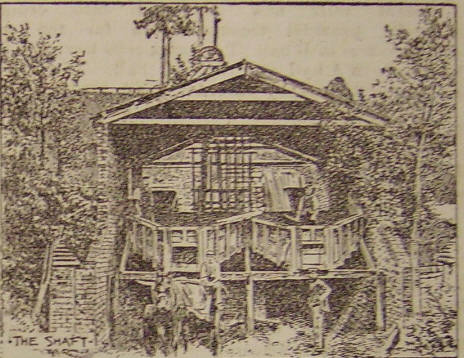
When the required quantity has been deposited, large iron grates are placed down the centre of the lower portion, and in theses large fires of coke or anthracite coal are built. One or other of these substances are used for fuel on account of their not causing smoke whilst burning, as the presence of smoke is injurious to the earth. Passing along a little further, we come to a number of other furnaces, built on a somewhat different and more modern principle, the floor being composed, as in the other case of perforated moveable iron plates. Behind the furnaces is a large lofty building, where the dried earth is stored, the doors of the furnaces abutting on it.
Here, the lump earth, which is the sort used for fulling purposes, is packed in sacks, and sent to all parts of the civilized world. The drying process takes in all about forty-eight hours. The machinery which is used for grinding is next inspected. Grinding suggests to the mind an immense wheel under which the earth is placed for the purpose to which it is adapted. But an examination of the machinery used for grinding fuller’s-earth discloses an immensely strong iron box, inside which two arms, with knobs at either end, are made to revolve at a high rate of speed in opposite directions. Small quantities of the earth are put in, and are pulverized by the action of the arms . As may be imagined, the earth is beaten down to different degrees of fineness, from the finest impalpable powder, used for toilet purposes, to one of a much coarser grain.
The process of separation is performed automatically. Running from the machines are lengths of wooden piping, and the pulverized earth is forced through these by the rotation of the arms of the pulveriser. The earth is carried along these pipes by the force of the draught, and is precipitated at different intervals, according to its fineness. It is then collected in sacks, and stored ready for use. The very finest impalpable dust is naturally carried the farthest, and this is collected at the extremity of the pipes, being used exclusively for toilet purposes.
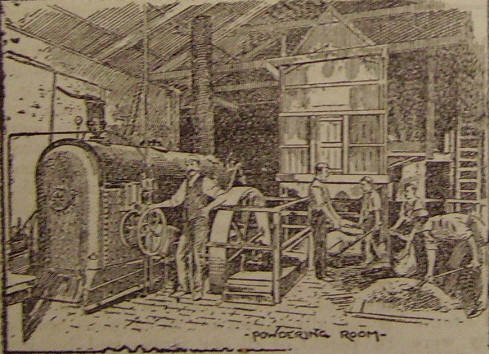
The two machines which this room contains – although they are both by the Cyclone Pulveriser Company – are somewhat differently constructed, though the principle of working is the same. We now pay a visit to the engine-room, where we see a magnificent engine of twenty horse-power nominal, but capable of being worked up to 100 horse-power, this supplying the motive power necessary to drive the whole of the machinery in use. While passing from here to the room where the finest of the earth is packed.
Packing for dispatch purposes is done by females, the room being fine and lofty, the light excellent and, and fact, the surroundings are everything that could be desired. Whilst standing here, we see on an eminence, about a quarter of a mile to the west, another of the company’s pits, but, as that is identically the same as the other one that been described, no further notice of it is necessary.
Before leaving the premises of this company, we cannot forbear noticing the offices, which are well appointed, every arrangement being made for the comfort and convenience of the clerical staff. From the works of the Woburn sands Fuller’s-Earth Co. to the mine of the British Fuller’s-Earth Mining Company is our next step, and a matter of about three minutes walk brings us to it. The buildings lie in a valley, and are very pleasantly situated. The shaft here is a perpendicular one, and is 70ft. deep, or 60ft. less than that of the Woburn Co. Entrance is gained to the mine by means of a cage, to which is attached a strong wire rope. Everything possible is done to ensure the safe working of the apparatus, as the slightest hitch might caused considerable damage to the well as well as loss of life. A fence, on one side of which is a gate, is placed round the mouth of the pit, so that there is no possible chance of anyone falling down, unless by design. On going down, we find that the method of working is precisely the same as that adopted in the other mine, the precautions for the safety of the workmen being also exactly identical. The mine is literally honeycombed with the tunnellings, which seem to point to the fact that an immense quantity of the precious earth has been taken out. The men work in twos, and can get out, on an average, about six tons a day, valued, in its rough state at about £1 a ton. In answer to a question as to how long the supply of earth will probably last, we are informed that, at the present rate of working, about thirty-five years will suffice to reach the limit of the supply, though the company would not mind if a demand sprang up for it which would exhaust it in half that time.
While we are standing on the top, a sound is heard which somewhat startles us, and we are informed that it is the signal to the engineer that a loaded truck of earth is waiting to be drawn to the top. The machinery is set going, and in less time than it takes to write it, the cage appears, the attendant on top taking the truck off and wheeling it to the side where the arts are loaded, which take the earth to be dried. After the truck has been emptied of its contents, it is wheeled on to the cage and let down to be once more re-filled. A noticeable fact about the works is the apple-pie order in which everything is kept, which tends greatly to facilitate the work that has to be done. We are informed that most of the property immediately surrounding the works either belongs to, or is leased by the company. An examination of the engine-house, and a word or two with the genial engineer brings to an end our inspection, and tracks are next made for the drying and preparing portion of the company works. The distance is rather long, and while we are passing down “Leighton Hollow,” we cannot help noticing the extremely sandy character of the soil, which as once suggests to our minds the reason why the village in which it is situated is called “Woburn Sands”. A good brisk walk for a quarter of an hour, through one of the prettiest villages in the country, brings us in site of the station works.
Arrived there, we are first conducted to the offices, which for comfort and convenience, would be hard to beat. The drying kilns, which are six in number, are similar to those which have already been described, anthracite coal or coke being also burnt in them. Repairs are constantly being needed to be made to these kilns, owing to the damage to the walls by the contraction and expansion of the iron plates. Passing through a rather low doorway, we enter the main building, where, under one roof, the sorting, grinding and packing processes are carried on. The machinery is perfect of its kind, the great principles of centrifugal force and gravitation being brought to bear in the process of separating the fine powder from coarse.
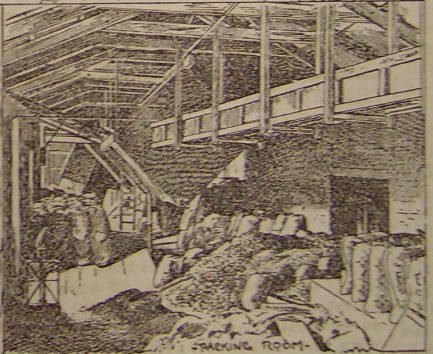
Owing to an unfortunate accident to the shafting, which occurred two or three days previously, we were unable to see the machinery at work, but our guide informs us that the earth is ground to a fine powder by the action of a set of arms set in a steel lined cylinder, and it is then, either by a direct blast or suction, distributed through a complicated system of chests and pipes, being deposited at different intervals according to its fineness, the very finest being carried along the whole length of the pipes – about sixty feet – when it is collected and sold for toilet purposes.
The engine which drives the machinery is a semi-portable of sixteen horse-power nominal, by Fowler. An interesting fact of which we are informed is that the pipe through which the water that supplies the engine is forced is place underground, and connected with the tank at the bottom, so that through the whole of the severe frost of last winter the water supply was not interfered with.
After taking a walk round and inspecting the bags of the earth which are being prepared for export, we depart, well pleased with the visit we have been enabled to pay to this most interesting concern, which may justly claim to be the most important industry in the neighbourhood. One of the most gratifying facts in connection with both concerns is the good opinion entertained by the proprietors of their employees. In the words of Mr. Milne, “They are a good lot of workmen. Everyman is interchangeable, so that if there is nothing for them to do in one direction they are employed in another.” The wages paid are also good, being much in advance of those received by the ordinary labouring man. As may be naturally expected, the introduction of such works into the neighbourhood has been strongly deprecated by a section of the population, whose sentimental regard for the beauty of the neighbourhood, and their desire to retain that beauty intact, has outweighed their public spiritedness; but there can be no doubt that the existence of such extensive works in the vicinity, affording remunerative employment for a large number of hands, is for the public good. While it is true that the buildings erected have somewhat marred the beauty of parts of the village, it is also true that many homes have been brightened by reason of the circulation of more money in the neighbourhood, which, but for the existence of these buildings, would never have been the case. In taking farewell of the works, which have been so inadequately described, we are sure our readers will join with us in wishing all those concerned in the undertakings every success, and if at all times things do not turn out as desired we would remind them of the immortal words of Addison, that – ‘Tis not in the mortals to command success, but we’ll do more, Sempronius, we’ll deserve it.” Salus populi suprema est lex*
[*The safety of the people is the supreme law]
The following account of the local fuller’s earth trade is taken from an article “Fuller’s Earth Working in Bedfordshire”, by Alan Cox, which first appeared in the Bedfordshire Magazine, issue 131, Winter 1979. I am indebted to Alan and Dr. Richard Smart of the Bedfordshire Historical Record Society for permission to reproduce it here.
Calcium montmorillonite clay, popularly known as fuller’s earth, is perhaps the most crucial of Bedfordshire’s mineral products. Deposits in this country are extremely limited and only occur irregularly in the Cretaceous Lower Greensands of Bedfordshire, Surrey, Hampshire, and Berkshire, and in the Jurassic series near Bath. It is a complex aluminium silicate, varying in colour from bluish-grey to greenish-yellow, and occurring as a seam up to about 10 feet thick and as much as 90 feet below the surface. Its extraction presents in a particularly acute form the dilemma inherent in most mineral operations, of weighing environmental considerations against the needs of industries upon which we depend for our modern standard of living. For fuller’s earth is used today in a number of vital processes and our balance of payments would undoubtedly suffer if more had to be imported (in 1970, for example, 176,000 tonnes of fuller’s earth were produced in the United Kingdom, while a further 49,000 tonnes were imported). National considerations have, therefore, allowed it to be quarried in the midst of some of the county’s most attractive woodlands around Aspley Guise and Aspley Heath. Fortunately the long-term effect on the landscape, provided that care is taken in restoration, need only be minimal. Nor is the extraction of fuller’s earth in this area anything new, for it has been dug here for centuries.
Fuller’s earth derives its name from its first use for fulling, that is the cleansing of wool after it has been woven, the earth acting as a detergent to remove grease and oil from the cloth. These qualities were well known to the ancient Greeks and they in turn passed on the knowledge to the Romans, who built public laundries or ‘fullonicae’ in their towns, and equipped a number of their villas with private laundries. The Romans certainly knew all about the fuller’s earth in Surrey and it is possible they also worked the Bedfordshire deposits, for there is evidence of Roman occupation near Aspley Heath.
During the Middle Ages the woollen industry was of great importance and fulling mills were widespread, but there is no definite record of fuller’s earth being excavated locally. It is, however, likely to have been dug long before the first documentary evidence appears in 1536, when William Hardyng was granted a lease for 40 years on certain property in the manor of Aspley Guise, including: ‘The Claypitts with appurtenances, called Fullyngpitts’. About this time it was also being worked at Wavendon – Old and New Wavendon Heath where much of it occurs were formerly in Buckinghamshire, but were combined with part of Aspley Guise in the 1880’s to form a new Bedfordshire parish called Aspley Heath. By the late 1570’s the earth was proving very profitable and there were five pits in the Wavendon area, although apparently only one was worked at a time, all the owners agreeing to share the profits between them.
The national importance of fuller’s earth was recognised by a series of Acts of Parliament from the reign of Charles II onwards prohibiting its export. Locally it was becoming important as well and in 1691 The New State of England reported of Aspley Guise: ‘…about this Town is digged up excellent Fullers Earth in great plenty’. Woburn, the nearest market town to the pits, was the natural centre for its sale; so much so that Thomas Cox, writing in 1715, remarked that the earth dug in this vicinity was commonly known as ‘Woburn-Earth’, and by the 1770’s it had become one of the principal trades of the town. Jefferys’ map of 1765 shows two pits, one at Aspley Guise in the angle between Weathercock Lane and Aspley Hill, and the other on the northern edge of Old Wavendon Heath, both on land then owned by Francis Moore of Eggington. The second of these pits was subsequently acquired by the Duke of Bedford. It is referred to in the Duke’s estate papers in the County Record Office, and quoted by permission of the Trustees of the Bedford Estates as the ‘fuller’s earth mine at Wavendon’ and in 1793 over 58 tons were sold at 6d (2½p) a hundredweight. More might have been sold, but as the Duke’s steward, John Fairey, explained two years later, there were problems over transport:
‘The fuller’s earth dug at Hogsty End, nr Woburn is of v. superior quality, a considerable quantity is sold to persons who fetch it from the pit, it goes to Witney in Oxon. and many other parts equally distant, but the land-carriage is so expensive it wn’t answer at the London market. By His Grace’s directions I sent 3 tons to town last year as an experiment, and to make its superior quality known; the carriage cost 455. [£2.25] per ton and hen arrived in London it sold at 20 [£1] per ton, probably Messrs. Smith, Mills, Birkett and Co. have some of it yet by them. Altho’ it won’t pay at present, I am in hopes of vending a consid. quantity in town when the Gd. Junction canal is completed, as the mine lies within 2½m.[iles] of the line…’
That working fuller’s earth was uneconomic at this time is borne out by Britton and Brayley, who in the first volume of The Beauties of England and Wales published in 1801, found that only the Duke’s pit was then operating, while the price of 10 shillings (50p) a ton was scarcely enough to cover the cost of excavation and no more than 30 tons was being sold annually. Daniel and Samuel Lysons writing shortly afterwards, suggested that the reason for this decline was that dealers were obtaining supplies of poorer quality earth from elsewhere and passing it off as ‘Woburn Earth’. Nevertheless, Fairey was eventually proved right about the canal and by 1836 sales from the Duke’s mine had increased very considerably, to just over 234 tons. The normal price was one shilling (5p) a hundredweight, but there were cheaper rates for bulk orders. Deposits of fuller’s earth are saucer-shaped so that it outcrops at the outer edges, but occurs deeper and deeper towards the centre. Naturally the shallower deposits were worked first, simply by digging pits and where necessary removing the top cover of sand. As late as 1780, when Thomas Pennant passed through the area, he saw a large open pit. By about 1800, however, it had become necessary to construct enclosed shafts to reach the earth which was actually mined at depths of 20 to 30 feet below the surface. Working conditions must have been decidedly unpleasant, for according to Britton and Brayley: ‘The pit at Wavendon consists of two shafts or tunnels; one with a ladder for the convenience of the labourers; the other to raise the earth up. The descent is disagreeable, and the inside of the pit very damp. The woodwork on the top and sides of the excavated angles is continually wet…’. Five, six or seven men might be employed, as and when earth was required. From about 1850 production seems to have been more erratic and in 1862 it was reported that none of the pits was being worked. However, excavation must soon have begun again and by the later nineteenth century the shafts were between 60 and 70 feet deep. The earth was dug out around the bottom of each shaft until a bell-shaped cavity had been formed, so that as much material as possible could be obtained without the workings collapsing. It was drawn up by hand using a windlass and a good shaft would produce 10 or 12 tons of earth. When a shaft had been fully worked, another would be sunk and the sand from it thrown into the abandoned one. Some galleries of the old working were discovered in 1958, together with an iron pick-head and two iron rings, probably from a wooden bucket used to raise the earth up the shaft.
This method of excavation was expensive and dangerous, and a more sophisticated one was introduced by the Fuller’s Earth Mining Company, formed in 1891. A works was built to the west of Sandy Lane, Aspley Heath, while further west a shaft was sunk 71 feet deep and designed to raise the earth by steam. From the bottom of the shaft headings were driven in different directions and strongly timbered to protect the workers from the sand above. When the earth reached the top of the shaft, it was transported to the works in small trucks on a tram line worked by steam. It was dried in kilns for about 48 hours and was then ready to be ground in the mill into different grades of powder, although some was sent away in dried lump form. Much of the processed earth was sent to the Yorkshire woollen mills and it was also exported to America and France. In spite of this, the works at Aspley Heath did not prosper for long and in 1900, by order of the High Court, were put up for auction, together with the works of a second company in the area. Apparently digging was resumed in 1919, but again only lasted for a short time.
Large-scale excavation only recommenced after the Second World War, when the Berk Chemical Company Limited started extracting fuller’s earth at Aspley Heath in 1951, close to the 1890s’ workings. The method of extraction used here and on other post-War sites is a mechanised version of the old opencast quarrying: the overburden and topsoil are removed by a scraper, and then the fuller’s earth is taken out by a dragline excavator. In all some 19 acres were worked on this site, yielding 50,000 tonnes of earth, which was transported by road to a processing plant at London Colney in Hertfordshire. Modern planning permissions allow only the actual fuller’s earth to be extracted, while the topsoil and overburden are stored for eventual reinstatement. At Aspley Heath working ceased in 1961 and the pit has already been refilled and grassed over.
Operations were then transferred to Aspley Wood where Berk’s successors, Steetley Minerals Limited, have nearly completed working an area of about 92 acres. A processing plant has been built on the site and about 50,000 tonnes of fuller’s earth a year has been dug here during the 1970s. Part of these workings have already been restored, although there have been set-backs in the reforestation programme and some replanting has been necessary.
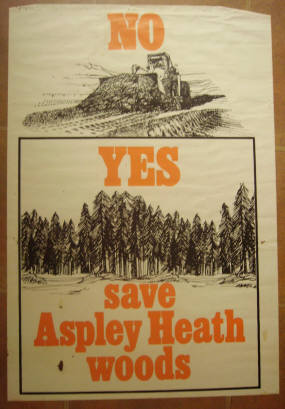
In 1976 Steetley applied for permission to extract fuller’s earth from an area of about 346 acres on the opposite side of the Woburn to Woburn Sands road, on Old Wavendon Heath. Because of the natural beauty of the wood here, there was strong local opposition and the application was refused by the County Council. However, following an appeal by the Company, the Secretary of State for the Environment agreed in March 1978 that working should be permitted in an area of about 189 acres on this site. A new bridge is to be built so that the earth can be taken across the road for processing at the existing works.
Fuller’s earth has also been found further along the greensand ridge, just south of Clophill. These deposits have never been commercially worked, but permission for extraction of about 300 acres was granted to Laporte Industries Limited in 1952. So far only trial excavations have been carried out, revealing that the fuller’s earth occurs 10 to 12 feet below a top covering of sand and gravel. At present this land is in agricultural use and when extraction does begin it will be necessary to minimise the impact on Clophill itself, since part of the permitted area is near the village. The earth is likely to be taken to Surrey rather than being processed on the spot.
And what happens to the fuller’s earth after it has been processed; One main use is as a bonding agent in foundry sand and the bulk of the earth from Aspley Heath was sold to Fords of Dagenham. It has also long been used as a filler in pharmaceutical and cosmetic products, and to a lesser extent in the preparation of certain mineral oils. After treatment it acts as a sealing compound for the emplacement of foundations in wet sites in the building and civil engineering industries. In an activated form, after treatment with acid, it is employed for clarification and purification of edible oils and fats. A more recent use is as a component in lubricants for drilling bits used on oil and gas rigs. Indeed, the list seems almost endless, for no doubt further uses will be discovered, and it is likely that the extraction of fuller’s earth will continue in Bedfordshire as long as suitable deposits are available.
The following extract from “Fuller’s Earth: A History of Calcium Montmorillonite”, 1986, by the late Robert H. S. Robertson, gives a detailed overview of the local workings. I am indebted to the Mineralogical Society of Great Britain for permission to republish the entry for Woburn.
What is Fuller’s Earth?
From Robertson’s introduction, the word ‘fuller’ and the French word ‘foulon’ are derived from the Latin word ‘fullo’, whose trade was that of scouring and felting cloth. In Roman times pieces of cloth were first soaked in stale urine or some other alkaline solution and then trampled on in a trough or vat containing a slurry of fuller’s earth (creta fullonia). Several rinses were given with clean water to remove the earth, which carried away with it much of the grease and dirt remaining in the wool The processes of making cloth were clearly well-developed and of great antiquity.
Woburn
Gums must be stor’d of Guinea’s arid coast; Mexican woods, and India’s brightening salts;
Fruits, herbage, sulphurs, minerals, to stain
The fleece prepar’d, which oil-imbibing earth
of Wooburn blanches, and keen alum waves intenerate.
John Dyer, The Fleece, 1751.
Fuller’s earth was worked for centuries in the parish of Wavendon. Wavendon, like many other Buckinghamshire parishes, was divided into districts or end-ships, amongst which were Church End, Duck End, and Hogsty End. Hogsty End is that part of Wavendon parish which was afterwards detached and incorporated in Woburn Sands.
Just as the Surrey fuller’s earth occurs near the village of Blechingley, the meaning of which may be taken as Bleaching-ley or -field, the Woburn fuller’s earth lies scarcely five miles from Bletchley. Indeed the Roman station of Magiovinium may have been sited near Little Brickhill on Watling Street so as to provide a laundry service for the troops.
The Woburn Sands and Aspley fuller’s earth deposits are now in the county of Bedfordshire. The earliest written reference to fuller’s earth in Britain is in the Inquisition of the Manor of Aspley, 7th February 1295:
there are there forty customary (tenants) and two cottagers of which each will mow the lord’s meadow for one day with one man, and each mowing is worth 4d….14s 0d
each will hoe for one day with one man, and a hoeing is worth ½…. 21d
each of them will cart for one day the lord’s hay or (?) fuller’s earth at the lord’s food, and each work is worth 1d…3s 6d
It is not until 1539 that the fuller’s earth here is mentioned again, in a deed of Henry VIII. The workings were almost certainly at the outcrop at that time, between Aspley Guise and Woburn Sands. In the parish of Wavendon, the Manor of Hugh de Bolebec was later in the hands of the Earl of Oxford and afterwards the Courternays, from whom it passed to John Sheppard in 1557. Some of the pits of fuller’s earth are mentioned in the grant on the estate.
Owing to its inland situation and the poor state of the roads, the Woburn fuller’s earth was never extensively worked in early days, though a pamphleteer in 1630 wrote that apart from the better known deposits in Kent, the only other one known to him was at Wooburn in Bedfordshire. However the Merchant Adventurers reminded the clothiers of the kingdom in 1639:
as the clothiers still suppose there is no other earth nearer than Kent, they are put in mind that Wooburn in the county of Bedfordshire is the best in all men’s judgement in England.
The Philosophical Transactions of 1684 says there is fuller’s earth of a yellowish colour at Brickhill, Northamptonshire (sic); the place was correctly given in 1723.
VI- An Account of the Pits for Fullers-Earth in Bedfordshire; in a Letter from the Reverend Mr. B Holloway, F. R. S. to Dr. Woodward, Pr. Med Gresh. S. R. & Coll. Med. Lond. Soc. Bedford, 6 July 1723.
Holloway said there were several Fullers-Earth Pits then open at Wavendon near Woburn, but men were at work only in one when he visited the place. The seam was approached vertically, first through reddish sands to a stratum of red sand-stone which had to be broken through before dropping a further 7 or 8 yards to the top of the fuller’s earth; the following varieties being recognised: the top foot, called cledge, is contaminated with sand and thrown away; then an inch of clay looking like Terra Japonica. The lower part of the seam is not tinged with red, and seems to be the more pure and fitter for fulling. Sand occurs below the seam but the men seldom penetrate as far.
He recognised that the Cretaceous rocks could be traced for many miles and that these occurrences confirmed what Woodward had said about the regular disposition of strata over large tracts of country. He suggested that other occurrences of fuller’s earth ought to be found elsewhere along the outcrop. This is an early instance of the application of stratigraphy for economic purposes.
John Woodward, physician and geologist, to whom Holloway’s letter was addressed, was the first British author to publish a work solely devoted to mineralogy, 1729. Woodward said “The fuller’s earth of England is very various, and it very much exceeds any yet discovered abroad in goodness, which is one great reason why the English surpass all other nations in the woollen manufacture,” – an exaggeration, it is now known.
The Woodwardian Collection which still exists in Cambridge in splendid cabinets, contains a sample of “Fullers-Earth, of a grey colour, with a Cast of greenish yellow. From Wooburn in Bedfordshire.” It is interesting because it shows current bedding, evidence of its derivation from volcanic ash. This was illustrated in an article on the origin of fuller’s earth by Cowperthwaite et al. (1972). The sample preserved at Cambridge was possibly sent to Woodward by Holloway, shortly before the collection was complete.
Thomas Pennant, the well-known naturalist, author and traveller in his Journey from Chester to London (1782), speaks thus of the Wavendon fuller’s earth pits:
Near the road side are the noted pits of fuller’s earth, that invaluable substance which is supposed to give the great superiority to the British cloth (honestly worked) over that of other nations.
Pennant then makes a precis of Holloway’s paper, but adds:-
The great use of this earth is cleansing the cloth, or imbibing the tar, grease and tallow, which are so frequently employed by the shepherds, in healing the external diseases which sheep are liable to; neither can the wool be worked, spun or woven, unless it be well greased. All this grease must be gotten out, before the cloths are fit to wear. Other countries either want this species of earth, or have it in less perfection. The British legislature therefore have, from the days of Charles I, guarded against the exportation of it under severe penalties.
In Pennant’s time, the working of fuller’s earth at Wavendon was evidently a going concern, but increase in the depth of overburden brought this phase of the industry to a standstill. At what date the “earth wells” were introduced is unknown. Nevertheless the Lysons (1806), quoting Pennant, write of a celebrated fuller’s earth pits at Wavendon, one of which is occasionally worked, in a close shaft. On the other hand the pits at Aspley Guise had not been worked for many years. The sale of the earth even from the Wavendon
pits has of late much diminished, the dealers got into a practise of procuring earth of an inferior quality from other parts of the Kingdom which sell as the produce of this neighbourhood.
The district however remained one of the recognised sources of fuller’s earth in England; the Third Edition of the Encyclopedia Britannica (1797-1810) and Manning and Bray (1809) record it as occurring at Aspley near Woburn in Bedfordshire, J. Sowerby (1809) says that Bedfordshire and Hampshire are the only two places mentioned by most authors where fuller’s earth occurs but elsewhere give details of the earths of Surrey and Kent. J. Nightingale (1816) explains that the fuller’s earth procured at Wavendon on the borders of Woburn is dug in Buckinghamshire not Bedfordshire as other authors state. However Phillips and Conybeare wrote in 1822 that fuller’s earth “was once extensively dug in Bedfordshire” – so operations had presumably ceased.
The Reverend John McArthur, Minister of Kilcalmonell and Kilberry, Argyll, upon enquiry learned that on the Duke of Bedford’s property fuller’s earth has been of great value as an article of commerce, and considerable quantities have been exported to foreign countries, (1845). Reverend J. R. Jackson also records the working of fuller’s Woburn in his “Minerals and their uses, in a series of letters (1849). The quality seems to have been good, for the Encyclopedia Britannia eighth edition in 1861 states that the best fuller’s earth comes from here and Surrey. Des Cloizeaux considered it important enough to include among his list of nineteen occurrences of fuller’s earth in the world (1852.)
It is not until 1885 that further information was given by A. C. G. Cameron of the Geological Survey. He maintained that the fuller’s earth which is dug from near the base of the Bedfordshire Greensand is of quality, and characterises it as a purifier of water. Fuller’s earth was at that time worked at Aspley Heath where cylindrical holes, called ‘earth wells’, were dug deep in the sandy rocks to reach the fuller’s earth, which occurs as a nearly horizontal stratum not far above the Oxford clay.
H. B. Woodward (1887) said that the fuller’s earth occurs rather below the middle part of the Lower Greensand, as follows:-
sand 130 feet
fuller’s earth 12 feet
sand 80 feet.
George Dames, who had been Secretary of The Fuller’s Earth Union a year, decided, probably early in 1891, to reinforce the efforts of the British Fullers’ Earth Co. Ltd., founded by Mr A. J. G. Swinney, a mining engineer, and Mr. George Edward Dixon, India Merchant of Leeds. These two joined George Dames of Woburn Sands on 23rd July 1891 in forming the Fuller’s Earth Mining Co. Ltd. Thomas Riley, a traveller from Leeds, may have introduced the parties, and was supported by Sam K. Riley, Boot & Shoe Engineer. Between them they raised £5000 to buy as a going concern Dixon and Swinney’s business, which consisted of one mine on the edge of Aspley Heath and a drying and grinding works beside the railway station at Woburn Sands where a “Niagara” mill had been installed.
The Fuller’s Earth Mining Company was a more impressive under-taking. The clay was hauled up to the works in little trucks, dried and then ground in a “Cyclone” or pulverising mill. The whole plant was in operation before the end of 1891, according to A. C. G. Cameron, who led a party of the Geologists’ Association to both works on 25th June 1892. The well-timbered mine was lit by many candles to let them see the earth in situ.
George Dimes said that fuller’s earth in boiler water prevents the growth of incrustation. It is well known to every housewife that boiling a lump of fuller’s earth softens the hard crust in a kettle so that it can be easily removed by rubbing. The textile market had declined but Woburn fuller’s earth was already being exported to America to decolorise cottonseed oil. The artificial preparation of ultramarine, paper making, the extraction of grease spots from wall papers, scouring butter boards, hearthstones and the like, are all facilitated by the use of fuller’s earth. Therapeutically, besides being used externally, it is even swallowed or taken as snuff. It could be mixed with blacking boot polish.
Cameron returning to the subject in 1893-4 maintained that a great deal of the fullers’ earth of commerce comes at present from Woburn Sands. Indeed the industry there employed some hundred men. He also referred to a curious feature of the stratum of fuller’s earth, though fairly horizontal – it rests on undulating ridges and furrows. These were later revealed in an opencast mine near Aspley Lane, Woburn, and mapped by I. A. Cowperthwaite.
The Fuller’s Earth Mining Co. was wound up in 1896 for reasons which are not known. Can it be that George Dames had fallen ill? All that known is that he died some time before September 1899 and by order of the High Court of Justice these noted fuller’s earth works were offered for sale on the 18th September 1900, as a going concern, in one lot.
Mining by the new owner continued fitfully until World War 1; at least 590 tons were got in 1915, but all activity had ceased by 1918.
Rastall notes that 6 feet of fuller’s earth occurs near the top of the Parish Sand Pit at Aspley Guise (quoting from Cameron); and in 1934 a further exposure was reported by E. E. L. Dixon at Clophill about 5 miles east of Ampthill. This was acquired by The Fuller’s Union Ltd, which had workings in that area in the 1950s.
Fuller’s earth workings, started by F.W. Berk and Co. Ltd. in Tidbery Fields at Aspley Heath, not far from the Iron Age fortifications known as Danesborough. The overburden was about 22 feet. Digging and carting ran from early May 1951 to February 1952, but was resumed in 1956 when their associated company, the St Albans Sand & Gravel Co., extracted over the next few years some 50,000 tons for processing at London Colney. Berks started a much larger operation in Aspley Wood in 1963 and when supplies were running out about 1980 their successors Steetley Minerals Ltd started a spectacular open cast mine on the west side of the Woburn – Woburn Sands
Other points of interest are the discovery of a Roman coin at Aspley Guise, the name Fulbrook Secondary School at Woburn Earth Lodge and Kiln Ground, the last being 1½ miles SW of Woburn Sands on the Little Brickhill road.

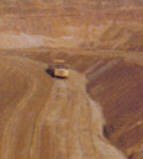
Readers are directed to the late Mr. Robertson’s book for further details of other uses for Fuller’s earth etc., and copies of the book are available by contacting the Mineralogical Society at www.minersoc.org
The story continued after Robertson’s book leaves off in 1986. The ‘spectacular’ open cast mine operated for many years. A bridge was built over the Woburn – Woburn Sands road, so that the fuller’s earth could be transported to the processing plant without obstructing local traffic on the A5130. Eventually, the centre section of the A5130 between Woburn Sands and Woburn was entirely rebuilt, and the cutting it ran through removed, giving a safer, wider road and so the firm could extract what fuller’s earth remained under the old road.
In the late 1990’s, Steetley Woburn Bentonite Ltd, (by now a wholly owned subsidiary of a private Spanish-owned minerals and mining company, TOLSA) tried to get permission for a new opencast mine that would encompass the turning for Longslade Lane, and extract approx. 320,000 dry tones of material. Despite a high-profile campaign by the firm to win support locally, producing facts and figures and marketing campaigns, with suggestions of screening of the works with new trees, working where the mineral was shallowest first, and using the overburden to alleviate noise etc; many villagers thought the prospect of such a huge opencast mine visible from most of northern Woburn was too much to bear, and “The Campaign to Protect Woburn and District from Open-cast Mining” fought the application. The main arguments were over the closure of local roads, mitigation of works, the increase in traffic for transporting the material, the hours of working and restoration of the heath after the mineral was extracted. The Campaign produced a 16-point list that local residents could write to the Principle Planning Officer at Bedfordshire County Council to object with.
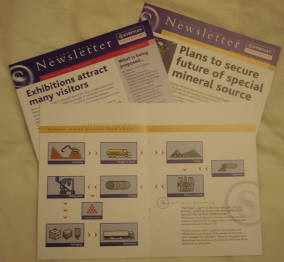
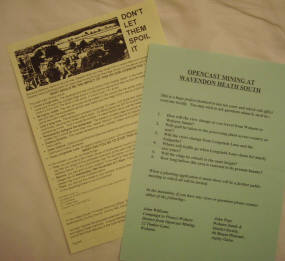
In support of his constituents, Mr. Jonathan Sayeed M.P. even raised it in the House of Commons, on 8th March 2001, giving a speech that included:
“…the plans of Steetley Woburn Bentonite Ltd. irrevocably to despoil the landscape of one of the most attractive parts of Bedfordshire so that its foreign parent company can make marginally more profit…. The product that Steetley wishes to surface quarry is fuller’s earth, which is processed with other materials into bentonite. It then has a number of applications, including being used for cat litter. Fuller’s earth has been extracted locally continuously since the 1950s and the quarry was most recently extended in 1993 on a marginally won appeal. However, that work took place in an area that was not visible to most people.
…The current application, however, is for a site of 58 hectares -146 acres – of highly visible open farmland. It would remove the whole of a wooded ridge between Woburn and Aspley Heath and Woburn Sands, and it is part of the famous Greensands ridge. It is greenbelt land, designated as an area of great landscape value – an AGLV – and it is close to two sites of special scientific interest. The nearest residential property is only 10 metres away.
… it wants to dig up thousands of tonnes of soil, chop down a 260m band of thousands of trees, cause dust, noise and pollution for 20 years and blight the countryside and the lives of thousands of people.
What of the national interest? We know that only a fraction of fuller’s earth is used in United Kingdom paper making and that alternatives are available. The majority is exported, so there can be no national interest. Nor are the sums involved so large that their loss would even be noticed. The despoiling of Woburn would be worth £2 million a year to Steetley’s parent company, but its effect on Woburn would be profound in terms of noise, dust, loss of amenity, disturbance of roads, destruction of the landscape and loss of jobs.
Woburn is the second-largest tourist destination in Bedfordshire. Walking in the area is a major visitor attraction. Anything detrimental to the visual attraction of the area will deter visitors. Eight circular walks through the area that is covered by the planning application begin and end in Woburn, and there is a new millennium walk. Whereas only two Woburn residents depend on Steetley for their livelihood, 170 Woburn residents are employed in tourist-dependent businesses.
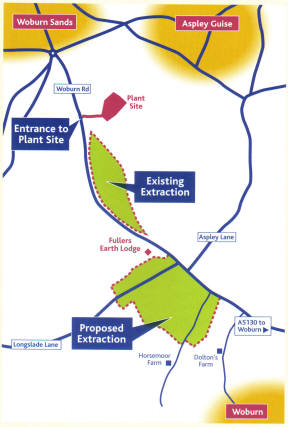
There is no need for the site, as I have shown, and there is demonstrably no national interest at stake, as I have proved. I await the Minister’s assurances that this shoddy, shabby and selfish campaign by Steetley will get no help from a Labour Government.”
The planning application was eventually turned down, so the diggers ceased digging, the mill ceased milling, and the plant was decommissioned in December 2004. British Geological Survey have estimated that there is still 320,000 dry tonnes of Fullers Earth in the Wavendon Heath South area, but a rapidly deteriorating market, and strong local objections, mean this reserve will stay in place.
Page last updated Aug. 2021.
